E-commerce Email Marketing: Free Templates Included
Table of contents
- What is Ecommerce Email Marketing
- Strategies for E-commerce Email Marketing
- Personalization at Scale
- Multi-Touch Email Campaigns
- Advanced Testing and Optimization
- Tools for E-commerce Email Marketing
- Choosing the Right Tool
- Why Email Marketing is Crucial for E-commerce
- E-commerce Email Marketing Case Studies
- Advanced Tactics for E-commerce Email Marketing
- Key Metrics to Track
- Common Pitfalls
- Trends in E-commerce Email Marketing
- Full Potential of E-commerce Email Marketing
Marketing is changing day by day. Mountains of content served daily on social media and websites make e-commerce email marketing a distinguished way to directly reach customers. But why, and how?
We have gathered an article for you on how to start your e-commerce email marketing campaign, what to consider, what types of emails are important, such as abandoned cart emails or welcome series, how to build e-commerce email marketing templates for different stages of the user journey, and which tools to use. For those who are too impatient to read the whole article, here are some key points:
TL;DR:
- In e-commerce, email marketing is expected to remain the most effective marketing channel in 2025.
- Top five most important types of emails in e-commerce email marketing are welcome emails, abandoned cart emails, order confirmation emails, promotional emails, and product recommendation emails.
- Abandoned cart emails are perfect for recovering lost sales. Using limited-time discounts fosters FOMO (fear of missing out).
- Post-purchase follow-ups build loyalty through gratitude and bring more sales with personalized product suggestions.
- Users find personalized birthday and anniversary emails helpful for customer relationships, especially if they come with exclusive offers.
- Re-engagement campaigns revive interest by updating past customers on new products and offering exclusive deals.
- Personalization, such as dynamic content and behavioral targeting, enhances customer connections.
- Automated multi-touch campaigns target customers at different lifecycle stages, from awareness to decision-making.
- Advanced tactics like AI, cross-channel integration, and interactive email elements improve engagement.
- Tools like Klaviyo, Mailchimp, Omnisend, ActiveCampaign, and Tabular.email offer varied solutions for e-commerce email marketing.
- Key metrics to track for your email marketing campaigns include open rates, click-through rates, conversion rates, and customer lifetime value (CLV).
- Always avoid spammy or low-value content for effective campaigns.
- E-commerce email marketing trends for 2025 include AI-driven personalization, GDPR compliance, and augmented reality integration.
- At the end of the day, success in e-commerce email marketing relies on staying updated, leveraging technology, and knowing your customers.
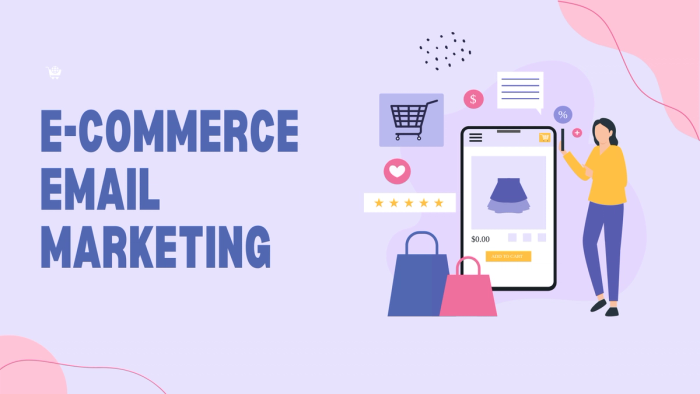
What is Ecommerce Email Marketing
Adapting to digital strategies has become a must in nowadays’ marketing field. To see the successful and bright days in your business, you must identify methods that resonate with the evolving demographic of internet citizens, commonly referred to as netizens. One effective way to connect with these netizens is by sending direct messages tailored to them. And yes, we’re talking about email marketing e-commerce.
Email marketing for e-commerce is the practice of using email to promote products, build customer relationships, and drive sales for online businesses. It involves sending targeted, personalized messages to a brand’s subscribers or customers to engage them at various stages of their shopping journey. With email marketing, businesses can nurture leads, convert prospects into buyers, and retain existing customers by offering valuable content, promotions, and product recommendations.
Email marketing has remained a powerful tool since its inception. Throughout marketing history, various email templates have enabled businesses to engage with their customers effectively. Emails can be use to boost sales, enhance customer engagement, and drive repeat purchases. Essentially, think of all the meaningful conversations you can have through face-to-face communication and imagine adapting those into templates for marketing purposes.
Strategies for E-commerce Email Marketing
As email marketing e-commerce offers a variety of email templates and strategies, it’s important to select those that align best with your business model. Consider this section as a resourceful pool of strategies for you to explore. Happy hunting! We hope you discover the perfect strategy to implement.
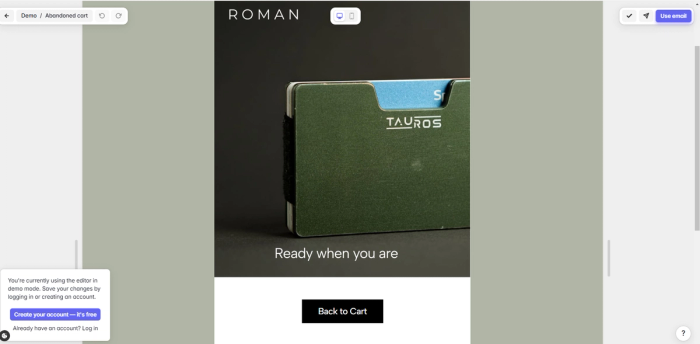
Abandoned Cart Emails
Life happens, and some carts remain abandoned. While it can be frustrating to see a purchase left incomplete, don’t worry—you can still reconnect with your customers. Use this opportunity to remind them about their abandoned cart or inform them of special offers. One of the great advantages of email marketing e-commerce is the ability to follow up with customers who left items in their carts. The power of email marketing enables you to bridge that gap effectively!
Best Practices
- To remind customers about the product or service, consider including high-quality photographs alongside detailed descriptions. These elements can recapture their attention and potentially convince them to complete their purchase—sometimes, all it takes is a little nudge.
- Did you know that many customers abandon their carts upon encountering shipping fees? This is your chance to win them back. Offering special deals or free shipping can encourage them to reconsider and finalise their purchase.
- The fear of missing out (FOMO) is a powerful motivator. Think about how often we buy unnecessary items during limited-time sales. Yes, we are talking about that lawnmower. To create a sense of urgency, use compelling terminology and attention-grabbing calls to action (CTAs) to prompt your customers to act before it’s too late.
Post-Purchase Follow-Ups
Consistency is key to successful communication. Your relationship with customers doesn’t end with the purchase; you can continue engaging with them during the post-purchase phase. This approach can help build loyalty and strengthen their connection to your business.
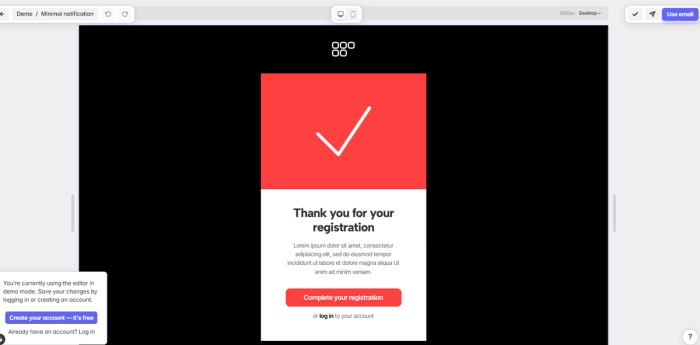
Best Practices
- Expressing gratitude is a great place to start. Sending a thank-you email for their purchase or subscription shows appreciation and sets a positive tone.
- To demonstrate that you value their investment, consider providing tutorials or care tips for the product or service. This not only ensures a longer product lifespan but also reinforces your relationship with them, making it a win-win situation for both.
- Additionally, recommending accessories or complementary products can enhance their experience. Suggesting items that other customers have paired with their purchase offers them more options and value. If they love to do shopping, we guarantee you they will appreciate your suggestions.
Birthday and Anniversary Emails
If this were a small-town community rather than a digital marketplace, you’d likely celebrate special occasions with your clients in person. To maintain these meaningful connections, you can still honor their special days through thoughtful gestures. Anniversaries, holidays, or birthdays are perfect opportunities to offer special deals or coupons that encourage sales.
Create your template using our email template builder.
Best Practices
- Few things say celebration like an exclusive sales offer. Use these moments to guide your customers toward making new purchases while strengthening your bond with them.
- Just as you might decorate your storefront with festive lights for Christmas, you can design your email templates with seasonal themes. Incorporate traditional motifs and patterns that align with your brand identity to create visually appealing and festive messages.
- One of the advantages of email marketing for e-commerce is the ability to tailor messages for individual recipients. Even something as simple as addressing them by name in the opening line can foster a sense of familiarity and strengthen their connection to your brand.
Re-engagement Campaigns
Reviving the interest of past customers can be just as impactful as acquiring new ones. Encourage them to revisit their purchase experience and customer journey with your brand. By maintaining a welcoming and respectful tone, you can successfully re-engage their interest.
Create your template using our email template builder.
Best Practices
- There’s no need to hold back—these customers already know your brand. Share updates about your existing products or introduce entirely new offerings. There’s a strong chance they’ll return for new purchases.
- Email subscribers deserve recognition. Show your appreciation by offering them special deals, reinforcing their value as part of your brand family. Highlighting their importance can help nurture their loyalty.
- Successful sales are often a result of effective communication. Adopting a friendly and authentic tone can strengthen your connection with customers. Always keep in mind that great salespeople master the art of rhetoric and meaningful conversation.
Personalization at Scale
- Dynamic Content: Especially in the 2020s, with the rise of AI, people crave interactions with marketers that feel human, not automated or robotic. One effective way to break through this perception is by personalizing your messages. By addressing your customers by name, referencing their previous purchases, or acknowledging their interests in emails, you can create a more personalized experience. This approach helps them feel more connected to your brand identity.

- Behavioural Targeting: One of the best email marketing tools for e-commerce is the ability to segment your recipients. You can categorize them based on their purchasing and consumer behavior. Through segmentation, you can target specific groups with relevant products, which will ultimately improve your overall click-through rates.
Multi-Touch Email Campaigns
Using customer lifecycle stages to plan your marketing workflow can significantly benefit your business. Anticipating these stages helps guide the creation of effective email campaigns.
- Awareness: Every purchase is driven by a specific need. Customers first identify a problem and seek the best solution that fits their needs and budget. During the awareness stage, you can send welcome emails to introduce your brand and its identity. By offering educational content about your product, you can further clarify your offerings.
- Consideration: Once customers recognize their need, they begin to seek supporting arguments on where to make their purchase. You can address their concerns and build trust by providing case studies and genuine customer reviews.
- Decision: At this stage, encouraging customers to finalize their purchase is crucial. You can provide them with special offers such as free shipping or sales to turn this whole process in actual sales.
Advanced Testing and Optimization
- A/B Testing: Different formulations resonate with different customer segments. To determine if your strategy is effective, conduct A/B testing and optimize your email marketing service for e-commerce. By preparing multiple email variations, you can test which one performs best.
- Predictive Analysis: Leveraging artificial intelligence for data analysis provides a great opportunity to assess whether your customers' behavior aligns with your brand's marketing identity. This enables you to tailor your approach to meet the specific needs of the customer demographics you serve.
Tools for E-commerce Email Marketing
- Klaviyo: With its click-to-purchase funnels, Klaviyo offers advanced automation tools that allow users to automate their content delivery. By streamlining the process of sending emails to segmented target audiences, it saves time and ensures efficient communication.
- Mailchimp: Offering pre-built templates, Mailchimp helps design your marketing strategy with ease. Its user-friendly interface makes it an ideal e-commerce email marketing software for beginners.
- Omnisend: Omnisend is a versatile tool for reaching your customers through not only email but also SMS, enabling multi-channel communication.
- ActiveCampaign: ActiveCampaign is an excellent choice for those looking to build an e-commerce email marketing automation strategy. With powerful automation features and CRM integration, it allows users to track and analyze their marketing campaign performance.
- Tabular.email: Tabular.email supports users throughout every stage of creating a successful marketing strategy. You can design personalized email templates using responsive design tools and leverage advanced analytics for targeted campaigns. Additionally, it allows users to test their marketing efforts for optimized results.
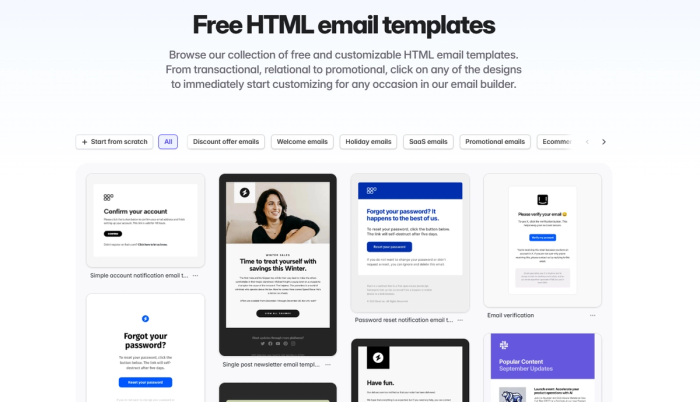
Choosing the Right Tool
So far, we've discussed why email marketing is important for e-commerce. However, it's crucial to note that these strategies will only be effective if you plan your marketing campaign efficiently. There are several factors to consider before choosing which tools to incorporate into your strategy.
- It's always better to be safe than sorry. Before investing your time and money into an e-commerce email marketing software, make sure it is compatible with your store.
- Budget and scalability are also key factors when selecting the right tool. Comparing your needs with the features and offers of each tool can help you find the most suitable option.
Why Email Marketing is Crucial for E-commerce
- High ROI: When investing in a marketing strategy, businesses expect efficiency and high returns. Email marketing demands minimal investment of time and effort. Once you've set up an e-commerce email marketing automation system, you can anticipate a high return on that investment.
- Customer Retention: Sending specific email templates on a consistent schedule helps you maintain a regular workflow. With this consistency, you can build long-term relationships through email communication. So, maybe the email marketing was the friends we made along the way, who knows?
- Increased Sales: Targeted promotions help remind potential customers about your offerings in a professional manner, enabling you to sustain and nurture your sales effectively.
- Brand Loyalty: As mentioned, personalized messaging in emails can capture your customers' attention. Starting with cold emails and continuing through consistent communication, you can strengthen your brand’s relationship with your audience.
E-commerce Email Marketing Case Studies
A great way to illustrate the importance of email marketing for e-commerce is by highlighting how other brands have successfully adapted their strategies. Below are some case studies that showcase their approaches:
Yuool
Yuool, a Brazilian shoe brand that began its journey in 2017, has now expanded globally by adopting effective marketing techniques. The brand emphasizes empathy with its customers by analyzing consumer behavior and using appropriate tags to segment its audience. Leveraging Mailchimp as their email marketing platform, Yuool designs personalized content tailored to individual needs. In 2022, Yuool completed 13% of its sales through email marketing. By building a trusting community, 7.4% of their emails converted offers into sales, and 34% of their customers became repeat buyers.

QuyCup
QuyCup, a brand selling reusable travel cups, thermoses, and mugs, made a remarkable shift in 2020 by focusing on digital marketing. They worked on conveying their brand values genuinely to their customers. Using Mailchimp as their email marketing platform, QuyCup created a compelling brand identity that succeeded in engaging potential customers and communicating its unique value proposition. This strategy resulted in a 42.3% average click-through rate on their first email and a total series ROI of 850%, leading to substantial sales growth.
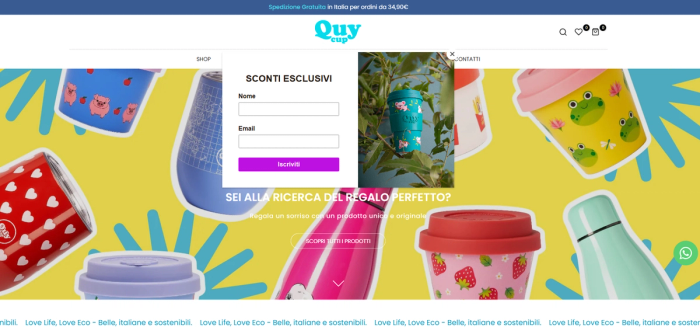
Nomad
Nomad built its success by increasing its revenue from 2% to 20% through effective segmentation using Klaviyo. They categorized clients into specific regions, such as the US and global markets, then further refined these segments by identifying users who opened the first email but didn’t complete their purchases. This strategy enabled them to achieve a 34% open rate for their initial email and 63% for the follow-up email. The reminder email contributed to 35% of total sales for their new product launch.
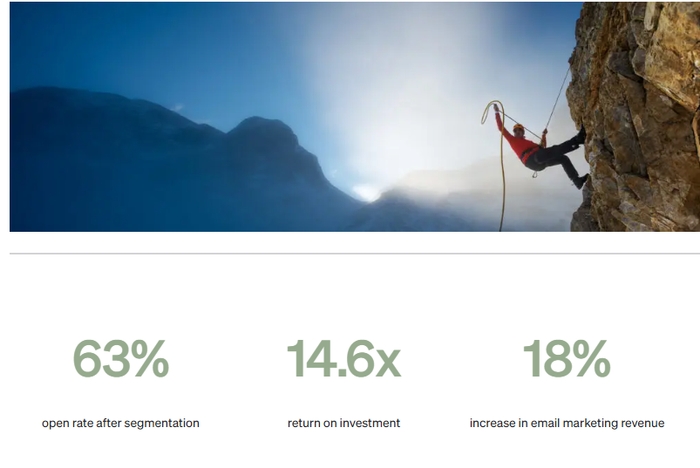
Advanced Tactics for E-commerce Email Marketing
AI and Machine Learning
Embracing new technologies and adapting your strategy to include them will give your business a competitive edge. Let's face it—AI isn't going anywhere anytime soon, so it's wise to work alongside it. By leveraging machine learning and AI, you can automate customer segmentation, enabling more precise targeting for your campaigns.
Cross-Channel Integration
Keep in mind that email isn't your only communication channel. While e-commerce email marketing is essential, you can also integrate SMS and social media campaigns into your strategy. If you find that a customer isn't engaging with your emails, consider retargeting them through other platforms to maintain a connection.
Interactive Email Elements
Not every marketing campaign needs to rely solely on lengthy text. You can make your content more engaging by incorporating interactive elements such as product carousels or gamification features. Adding special offers or gift codes within these interactive components can further incentivize customer engagement and increase the effectiveness of your emails.
Key Metrics to Track
Now that we know the best email marketing tools for e-commerce, it's time to see which strategies and tools work best for your business. Thanks to key metrics, you can track your success through customer data.
- Open Rates: Unlike social media ads, your recipients must click and open your email to view your offer. By crafting compelling subject lines and opening lines, you can significantly improve your open rates.
- Click-Through Rates: Opening your email and reading the content isn't enough to measure success. By including captivating explanations of your product and campaign, you can encourage customers to click on the links and engage with your content.
- Conversion Rates: This is the ultimate goal—turning marketing efforts into actual sales. You can measure the effectiveness of your strategy by tracking conversion rates, which helps define your ROI in terms of sales.
- Customer Lifetime Value (CLV): Your objective isn't just to acquire customers but to nurture and retain them. By offering valuable insights and personalized content, you can encourage customers to return, ultimately turning them into lifetime value customers.
Common Pitfalls
- You can send as many emails as you'd like, but if they end up in spam folders or are simply ignored by your recipients, your content will get lost. Pay close attention to the deliverability rates of your emails. If you notice that recipients are opening your emails only to close them immediately, it might be time to rethink your approach. It’s a "It's me, not you" moment.
- Sending promotional emails that offer no value will not work. Your customers don't want to feel like they're reading a sales brochure. You are a brand with values and priorities, so make sure your content reflects that. Create meaningful and engaging content that resonates with your audience.
Trends in E-commerce Email Marketing
In the future, email marketing is expected to maintain its prominence, but to stay ahead of the curve, it’s essential to keep up with new technologies and advancements in e-commerce email marketing.
- Online data is just as valuable as your physical identity, so safeguarding privacy and ensuring GDPR compliance should be a top priority for your business.
- AI-driven data integrations and content creation can greatly benefit your business. You can use AI to analyze consumer behavior and create a persona map that aligns with your brand.
- Online personas are fascinating, and it’s no surprise that people enjoy seeing how technology integrates into real life. To stay on top of e-commerce trends, consider incorporating augmented reality elements. Show your clients what their life could be like if they became loyal customers, providing them with an immersive, forward-thinking experience.
Create your template using our email template builder.
Full Potential of E-commerce Email Marketing
If you want to improve your business today, remember to stay updated with the latest e-commerce email marketing strategies!
As technological trends and new marketing strategies shape the business landscape, investing in a targeted email marketing approach is crucial. This includes utilizing automation to streamline communications and save time, as well as personalization to ensure your messages connect with each individual customer.
Thanks to technological advancements, you now have the power of AI to assist you. AI can enhance your ability to analyze consumer behavior and create tailored content, leading to better results. We hope this blog has inspired you to design a more effective workflow for your business. Happy emailing!